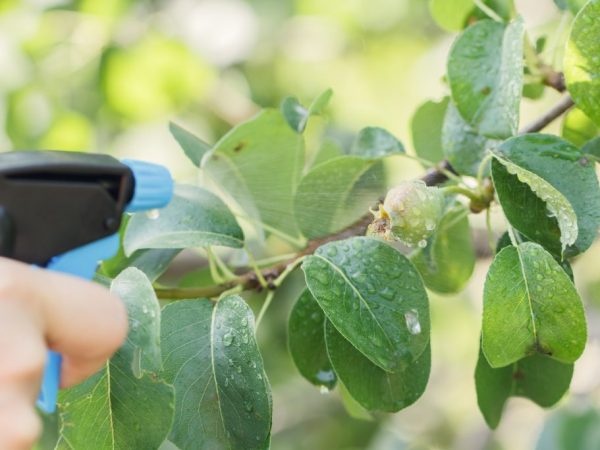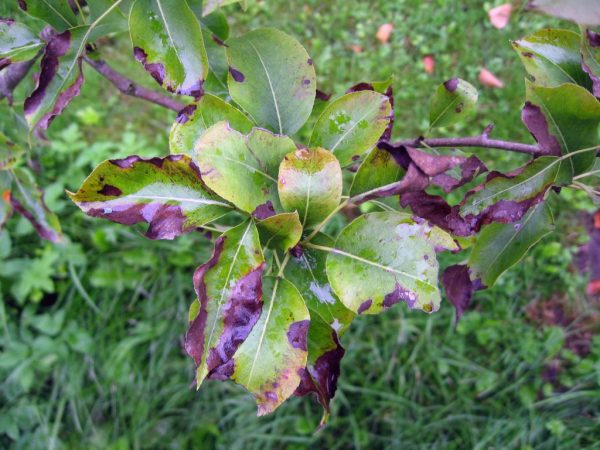How to treat pears for diseases and pests
Processing of pears from diseases and pests is carried out in spring and autumn. This process is a must in tree care. If you adhere to the terms and rules, you can achieve high fruit yields.

Rules for processing pears from diseases and pests
Spring processing
Pears must be sprayed at least 3 times per season.
The first time processing is done in early spring, in March, when the snow melts. This is done in order to control pests wintering in the bark or branches of a pear.
The second spraying is carried out in April, until the trees bloom and the buds swell, because at this time the larvae of the pests revive. They are also beginning to take preventive measures against bacterial and fungal diseases.
The following treatments are carried out during the flowering period. This happens in 2 stages:
- when opening buds;
- when ¾ petals fall.
The goal is to fight insects, prevent rot and strengthen immunity against fungi.
the last time pears are sprinkled in the spring is carried out after flowering in May. These are fixing procedures that significantly increase the resistance of the crop to diseases and finally kill pests.
How to spray
First of all, dead bark, moss, lichens are removed from the tree. To do this, use a brush or hard glove. You have to be extremely careful not to harm the healthy bark.
The first time the treatment is carried out when the air temperature is set above 5 ° C. All events are held in the early or evening hours. The weather should be calm and clear. The main thing is that the rain does not pass after the procedures, otherwise all efforts will be in vain.
It is necessary to spray all parts of the pear and the soil around the trunk. Particular attention is paid to cracks in the bark, because it is in them that a large number of pests and pathogens accumulate.
The treatment solution is used immediately after preparation. You must adhere to the instructions for use. An improperly diluted product can be either ineffective or harm the plant: burns appear. You also need to take care of personal protection: glasses, respirator, gloves, overalls.
It is necessary to process young trees with the help of mild preparations, because stronger means can lead to a negative reaction.
Diseases and pests

Disease destroys most of the crop
Various reasons can hinder obtaining a high yield. Among them are diseases that most often affect trees:
- Scab. It is caused by fungi. It infects leaves and fruits. It can be identified by greenish-brown spots on the leaves, the surface of which becomes velvety. Dark spots also appear on the fruits, they deform, crack.
- Rust. This is a fungal disease. Its signs are rusty spots on the leaves, which leads to their falling off, as a result of which the process of photosynthesis does not occur. There is no harvest for the next year.
- Fruit rot. On the fruits, you can see spots of brown or brown color.They appear due to the penetration of fungi into damaged fruits (with scratches, cracks).
- Powdery mildew. The disease affects foliage, flowers, young shoots and fruits. The branches are covered with a gray bloom, the characteristic presence of black dots on them. The leaves become white or rusty, causing them to curl.
Insects, which hide in the bark of a tree in autumn, also cause great harm. When processing pears for diseases, it is worth paying great attention to this problem. The most common pear pests:
- Aphids are small insects that suck sap. The leaves are deformed, the shoots are curled.
- The pear mite appears as brown swellings on the underside of the leaves. This leads to leaf fall and impaired bud formation.
- Copperhead is an insect that sucks juice from leaves, buds, fruits. They become covered with a clear liquid.
- The winter moth is a green caterpillar that feeds on the buds and then the buds and leaves.
- Goldtail - caterpillars of a dark tone with yellow villi, white and red spots. They eat leaves and buds.
Folk methods of struggle
For small lesions, as well as for preventive purposes, folk methods of pest control are used.
Against aphids, an infusion of tobacco is used, which is poured with water (1:10) and insisted for a day. The filtered concentrate is diluted with water in a ratio of 1: 3. For 1 liter of liquid add 4 g of liquid soap for better adhesion of the product. It is also sprayed with decoctions of black henbane, onion husks, dandelion, medicinal chamomile, celandine and other plants.
Hot red peppers help to fight aphids. It is taken in an amount of 1 kg (raw) or 500 g (dried) substance, poured in 10 liters of water, infused for 2 days, then boiled for an hour and insisted for another 2 hours.
It can be processed only before flowering in a diluted form: 0.5 liters per 10 liters of water, then add 40 g of liquid soap. After flowering, the dilution proportions are different: 100 ml per 10 liters of water. The remedy also has a positive effect against honeydew.
The tick does not tolerate dandelion-based products. They are prepared as follows: 1 kg of plants is poured into 3 liters of water, insisted for 3 days.
Chemicals
In March, as the first treatment, the pear is sprayed with diesel fuel. This process is optional.
At the second stage, use:
- 1% Bordeaux mixture;
- urea;
- copper sulfate (50 g of concentrate is diluted in 5 liters of water);
- 3-4% iron vitriol (300 g per 10 l).
Also, against reviving pest larvae, you can treat the pear with insecticides. The dosage is determined strictly according to the instructions of the drugs.
Spraying during flowering helps to increase the immunity of plants. For this purpose, Bordeaux mixture and copper sulfate are used. Anabasine, DDT powder, karbofos, calloidal sulfur are useful for ticks.
At the last stage of spring processing, a combination of a mixture of a wide spectrum of action is used. Agravertine is used to combat the moth.
Conclusion
Growing a high yield is the goal of every gardener. So that diseases and pests do not interfere with achieving a good result, preventive and therapeutic measures must be taken.
For greater efficiency, it is recommended to spray trees not only in spring, but also in autumn: then the pests will have no chance of survival.

